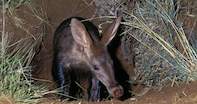
There are various smaller animals and unusually rare sightings that await safari-goers - your trained game ranger will happily point out the fascinating small creatures of the park on a game drive or safari walk. Rare sightings include the elusive aardvark, and pangolin, which will add interesting moments to your safari experience.
Guests will be pleasantly surprised to find that Kruger National Park offers amazing opportunities to see animals that were not on their checklist, but are gorgeous to view in their natural habitat.
African Giant Pouched Rat

The African Giant Pouched Rat is generally considered to be the Gambian Pouched Rat. Learn more about the African Giant Pouched Rat that is an omnivorous rodent that feeds on a wide range of food items.
African Weasel

The African Weasel preys almost exclusively on small rodents and young birds on the ground, whereas insects are taken on occasion. Learn more about African Weasel and see where they are found.
Ansorges Free Tailed Bat

This bat is smaller than most free-tailed bats, with a head-to-tail length of 106 mm and a mass of about 10 gr. Find out more about the Ansorges Free Tailed Bat rare species in South Africa.
Banana Bat

Banana bats do not feed on bananas but instead get their name from their habit of roosting in the leaves of banana trees. Find out all you know about the Banana Bat.
Cape Ground Squirrel

The Cape Ground Squirrel is predominantly herbivorous and feeds mainly on roots and bulbs. Learn more about the Cape Ground Squirrel that is a rodent endemic to South Africa.
Cape Otter

Since the Cape Otter is intelligent and playful by nature, they are charming to watch. Learn more about the Cape Otter that breeds throughout the year, and one to three young are born per litter.
Eastern Rock Elephant Shrew

The Eastern Rock Elephant Shrew is widely distributed in South Africa. Learn more about the Eastern Rock Elephant Shrew that is quite common in most areas and not threatened.
Greater Cane Rat

This rodent is closer related to the porcupine than to veld rats. This is all you need to know about the Greater Cane Rat that is regarded as a delicacy, superior to that of rabbit, that's why some people hunt it for food.
Honey Badger

Honey Badger is one of South Africa's most ferocious animals, known to attack Lions and Buffalo when threatened. Find out more about the Honey Badger that feeds on a wide variety of foods including eggs.
Jamesons Red Rock Rabbit

Jamesons Red Rock Rabbit has a fine, silky fur which is grizzled rufous-brown on the upper parts of the body. Learn more about the Jamesons Red Rock Rabbit that only occurs only in the northwestern region
Lesser Yellow House Bat

The Lesser Yellow Bat prefers to prey on airborne insects under the canopies of tall trees and riparian forests. Find out more about the Lesser Yellow House Bat and where they are found.
Long-tailed Forest Shrew

The Long-tailed Forest Shrew is an opportunistic feeder, taking a great variety of invertebrates. Learn more about the Long-tailed Forest Shrew that's endemic to the eastern regions of South Africa and Lesotho.
Mole

The Cape Golden Mole are small, blind, insectivorous mammals, and not remotely related to rodent moles. Find out more about the fascinating Cape Golden Mole
Mountain Ground Squirrel

The Mountain Ground Squirrel has previously been considered as a subspecies of the Cape Ground Squirrel. Learn more about the cute Mountain Ground Squirrel that can also be found in Northern Cape.
Rock Dassie

The Rock Hyrax is the African elephant's closest living relative, in spite of the size difference. Find out more about the Rock Dassie that are heavily prayed upon by eagles, Caracal and Leopard.
Scrub Hare

The Scrub Hare feeds mainly on short, green grasses, and during times of hardship, they'll take leaves. Learn more about the Scrub Hare that is widely distributed in South Africa but absent from forests.
Spring Hare

The vernacular name of this creature is misleading since the Spring Hare is in fact a rodent and not a hare. Find out more about the Spring Hare that is an important food source for people throughout Africa.
Striped Polecat

Polecats are close relatives of the African weasel, except that they are larger. Find out more about the Striped Polecat that is widely distributed and is fairly common throughout South Africa and in neighbouring countries.
Tree Squirrel

The Tree Squirrel is essentially an arboreal animal, but spends a great deal of time on the ground, foraging for food. Learn more about the Tree Squirrel that is primarily vegetarian, but like most rodents will take insect prey.
White-Tailed Rat

The White-Tailed Rat is a thickset, mouse-like rodent. Learn more about the White-Tailed Rat that's endemic to South Africa, distributed in the lower-lying areas of the Eastern Cape, westwards to the Western Cape.
Yellow House Bat

This is an attractive bat with a dog-like face, that feeds preferably on beetles. Find out more about the Yellow House Bat with numerous species in African and around the world.









